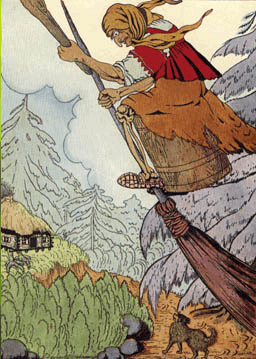Baba Yaga

Baba-Yaga (Баба Яга in Russian and also translated Baba Jaga) is a witch-like character in Slavic folklore. She flies around using a giant mortar and pestle, kidnaps (and presumably eats) small children, and lives in a forest hut, which stands on chicken legs. In modern days, she is often depicted not as a villainous, but simply a sociopathic or even gentle and friendly person. And in almost any tale she knows much. The 'Baba' word can be translated as impolite 'old woman' or 'big woman' or simply 'woman' -- usually the first one is correct for this trope; while 'Yaga' is a form of a certain name, it is thought to be a corruption of Slavic root for 'hag', making 'Baba Yaga' mean something like 'old hag', or perhaps 'hag hag'. Baba Yaga is depicted as an old, knowledgeable, and geeky character with mystical servants.
She is a common antagonist in Slavic folklore, known for kidnapping and eating children (and serving as a cautionary tale for small children against wandering off or talking to strangers). Some tales alternatively revolve around characters seeking her out for her wisdom or having her offer guidance to lost souls, though they are notably less in number.
The character of Baba Yaga has made dozens of appearances in popular culture and modern works including Orson Scott Card's novel Enchantment, the Fables and Hellboy comic series, innumerable Russian cartoons and tales, RuneScape, Quest for Glory, and (as "Barbara Jagger") Alan Wake. Baba Yaga is also a brand of beer from the Massachusetts-based brewery.
- All Witches Have Cats: Has one, at least in some stories. But she has other animals as well.
- Bizarrchitecture: Baba Yaga's chicken-legged home. It even apparently moves.
- Truth in Television: The Sami evidently used this style of architecture.
- Black Magic
- Cool Old Lady: In the stories where she is a helpful character rather than the villain.
- Eats Babies: Most of the time.
- Evil Aunt: In some stories, Baba Yaga has a beautiful, younger (but still evil) sister who seduces and marries widowed fathers in order to send her new stepchildren off to their new "aunt." Don't worry, they will usually escape with the help of their dead mother or something...
- Evil Old Folks
- The Fair Folk: Possibly related to them.
- Familiar: Usually has several, either animals, or her invisible servants, or both.
- Flying Broomstick: Sometimes, but she's usually depicted flying with the mortar and pestle.
- "Hansel and Gretel": Localised varieties of this fable sometimes make her be the witch the two meet.
- Iconic Item: She flies around in a giant mortar and pestle. Some later tales (and toys) depict her flying with the usual for witches - a broomstick.
- The hut on bird legs is also quite iconic.
- Impossible Task: In the story of Vasilisa the Beautiful, she gives the heroine a series of these, including separating grains of rotten corn from sound corn, and separating poppy seeds from grains of soil. Vasilisa accomplishes this via the aid of her mother's enchanted doll.
- Nature Spirit: Some stories claim this of her, stating she can create storms.
- Never Mess with Granny: She is an old powerful witch after all. Though in some stories, she suffers from Badass Decay.
- Public Domain Character Has shown up in Dungeons & Dragons, Quest for Glory, Fables and PS238. She is also a character in Warhammer Fantasy in Kislev.
- Sacred Hospitality: One thing you must abide by if you are bold enough to visit her house, although that does not guarantee safety.
- Sapient House: Her hut is able to move on its own with its chicken legs.
- Terrible Trio: In one story, she had three servants, mounted knights that represent the daybreak, the sun, and the night.
- Weaksauce Weakness: She is repulsed by parental blessings, the reason Vasilisa survived her encounter.
- Wicked Witch
- Wizards Live Longer: No one knows how old she is, but in some stories she's been around for a very long while.